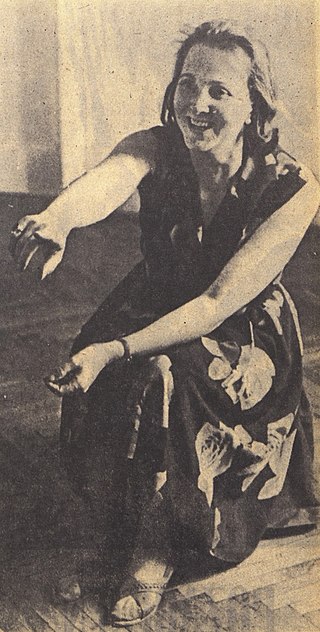
Goriška is a historical region in western Slovenia on the border with Italy. It comprises the northern part of the wider traditional region of the Slovenian Littoral (Primorska). The name Goriška is an adjective referring to the city of Gorizia, its historical and cultural centre.

Janko Prunk is a Slovenian historian of modern history. He has published articles and monographs on analytical politology, modern history, the genesis of modern political formations, and the history of social and political philosophy in Slovenia. He has also written on the history of political movements in Europe from the end of the 18th century until today, especially about Slovene Christian socialism and the history of Slovenian national questions.

Paula Gruden or Pavla Gruden was an Australian poet, translator, and editor of Slovene descent.

The history of the Jews in Slovenia and areas connected with it goes back to the times of Ancient Rome. In 2011, the small Slovenian Jewish community was estimated at 500 to 1,000 members, of whom around 130 are officially registered, most of whom live in the capital, Ljubljana.

Breznica is one of ten villages in the Municipality of Žirovnica in the Upper Carniola region of Slovenia. It is the seat of the municipality. Most of the village has developed on the slopes of the Reber range, leaving open fields towards the south and east. To the west the built-up area has extended to Zabreznica.

Edvard Kocbek was a Slovenian poet, writer, essayist, translator, member of Christian Socialists in the Liberation Front of the Slovene Nation and Slovene Partisans. He is considered one of the best authors who have written in Slovene, and one of the best Slovene poets after Prešeren. His political role during and after World War II made him one of the most controversial figures in Slovenia in the 20th century.

Draga Ahačič was a Slovene actress, film director, translator and journalist.

Mekinje is a settlement at the confluence of the Kamnik Bistrica and Nevljica rivers in the Municipality of Kamnik in the Upper Carniola region of Slovenia. It is considered a suburb of the town of Kamnik.

Marko Snoj is an Indo-Europeanist, Slavist, Albanologist, lexicographer, and etymologist employed at the Fran Ramovš Institute for Slovene Language of the Scientific Research Center of the Slovenian Academy of Sciences and Arts in Ljubljana, Slovenia. He served as director of the institute from 2008 to 2018. He has made numerous scholarly contributions to Indo-European linguistics, particularly in the realms of Slovene and Albanian, and is noted for his work in advancing Slavic etymology in both scholarly and popular domains. He is a full fellow of the Slovenian Academy of Sciences and Arts.

Tobia Lionelli was a Slovene–Italian preacher and writer in the Baroque period. His sermons had a crucial role in the affirmation of Slovene as a language. He is also known by his monastic name John Baptist of Sveti Križ in Vipava.

Rado Riha is a Slovene philosopher. He is a senior research fellow and currently the head of the Institute of Philosophy, Centre for Scientific Research at the Slovenian Academy of Sciences and Arts, and coordinator of the philosophy module at the post-graduate study programme of the University of Nova Gorica.
Konca Vas is a small settlement immediately north of Stara Cerkev in the Municipality of Kočevje in southern Slovenia. The area is part of the traditional region of Lower Carniola and is now included in the Southeast Slovenia Statistical Region.

Dvorska Vas is a village in the hills south of Velike Lašče in central Slovenia. The area is part of the traditional region of Lower Carniola and is now included in the Central Slovenia Statistical Region.
Murska Sobota railway station serves the municipality of Murska Sobota, Slovenia. It was opened in 1924.

Griže is a village on the right bank of the Savinja River in the Municipality of Žalec in east-central Slovenia. The area is part of the traditional region of Styria. The municipality is now included in the Savinja Statistical Region.

Lambert Ehrlich was a Carinthian Slovene Roman Catholic priest, political figure, and ethnologist.

Dobrava pri Črnučah is a formerly independent settlement in the northern part of the capital Ljubljana in central Slovenia. It is a dispersed settlement on both sides of the road from Ljubljana to Domžale. It is part of the traditional region of Upper Carniola and is now included with the rest of the municipality in the Central Slovenia Statistical Region.

Obrije is a formerly independent settlement in the northeast part of the capital Ljubljana in central Slovenia. It is part of the traditional region of Upper Carniola and is now included with the rest of the municipality in the Central Slovenia Statistical Region.

Zapuže is a former settlement in central Slovenia in the northwest part of the capital Ljubljana. It belongs to the Dravlje District of the City Municipality of Ljubljana. It is part of the traditional region of Upper Carniola and is now included with the rest of the municipality in the Central Slovenia Statistical Region.

Podgora is a former settlement in central Slovenia in the northwest part of the capital Ljubljana. It belongs to the Šentvid District of the City Municipality of Ljubljana. It is part of the traditional region of Upper Carniola and is now included with the rest of the municipality in the Central Slovenia Statistical Region.


















